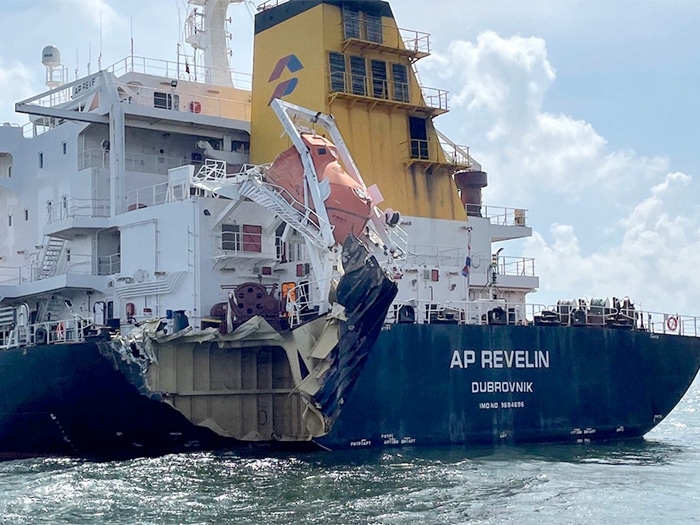
Oil mist detector malfunction likely caused $3.4 million collision
Written by Nick Blenkey
AP Revelin sustained $3.4 million in damage in collision linked to oil mist detector malfunction [USCG photo]
A false alarm from an oil mist detector is seen as playing a key role in an August 2022 collision in the Sabine Pass, Texas, involving an 18,143 dwt Netherlands-flagged general cargo ship and a 38,795 dwt Croatian-flagged bulker
The just-released National Transportation Safety Board (NTSB) report on the incident notes that it occurred at about 10.45 a.m., local time, on August 21, 2022, when the general cargo ship, the Damgracht, operated by Amsterdam-based Spliethoff’s Bevrachtings BV. was inbound in the Sabine Pass Outer Bar Channel en route to Beaumont, Texas, and the bulker, the AP Revelin operated by Dubrovnik-based Atlanska Plovidba was outbound. The two vessels collided after the Damgracht lost propulsion when its main engine shut down due to “high oil mist density” sensed by its oil mist detector (OMD). The engine shaft-driven electrical power take-off generator, which had been powering the bow thruster, stopped producing power, and the thruster stopped as well
Due to the abrupt loss of propulsion, the Damgracht began veering into the path AP Revelin. The pilot aboard the Damgracht took steps to notify and avoid the AP Revelin, but without the means to maneuver the vessel, the Damgracht and the AP Revelin collided. No injuries were reported. The collision resulted in $3.4 million in damages to the AP Revelin.
The day before the collision, the Damgracht’s main engine alarmed and shortly later shut down due to a high cooling water temperature. That evening, the engine crew cooled down the main engine and repaired a failed cylinder head gasket. The gasket failure likely allowed cooling water to leak into the cylinder and contaminate the engine’s lube oil system, and the work to repair it resulted in the interior sections of the engine being exposed to humid conditions. That evening the humidity averaged about 90%. It is likely that higher levels of water entered the crankcase than could be removed overnight by the lube oil purifier or evaporate from the heat of the running engine in the short time it was tested post-repair. While the Damgracht was underway the following morning, the OMD triggered a false alarm after sensing water vapor that had condensed in the sample.
The full NTSB report notes that:
“In 2007, before the Damgracht was built, the manufacturer of the OMD later installed aboard the Damgracht released a safety bulletin regarding high-humidity operations. The bulletin stated:
The oil mist detector (OMD) may trigger false alarms due to high humidity in the crankcase and condensed water in the OMD system suction pipes. The humidity/water buildup increases when the engine is started for the first time after being out of operation for several hours (e.g. during the night). If the lubricating oil has water content above the permissible limit, the oil mist detector will “perceive” high humidity (water droplets) in the optical path. A good practice would be to inspect the lubricating oil separators for any water contamination to the clean side of the oil or find out whether there could be cooling water leaks. Sometimes water droplets can be seen inside the measuring head when opening the inspection cover. Also, water may be found in the pipe connection box/valve box, causing false alarms.
“Investigators reviewed OMD maintenance records from 2020 up to the date of the casualty. The vessel’s operating company required a job order titled “Inspect and Test Oil Mist Detector” to be completed monthly. The job description specified: “Inspect oil mist detector and test if it is functioning correctly. If necessary, replace air filters and readjust airflow through measuring unit.” The vessel’s computerized maintenance program recorded that the crew had conducted numerous routine maintenance tasks in the 3-year period requested by investigators. In 2022, up to the date of the collision, seven maintenance activities were logged in the maintenance program. On August 17, about 4 days before the collision, the electronic maintenance log contained an entry stating that the required monthly maintenance on the OMD had been completed with no comments.”
PROBABLE CAUSE
The National Transportation Safety Board determined that the probable cause of the collision between the two ships was the Damgracht’s loss of propulsion caused by an automatic shutdown of the main engine due to a false alarm, likely triggered by water vapor sensed by the oil mist detector shortly after engine maintenance was completed to replace a failed cylinder head gasket during high-humidity conditions.
LESSONS LEARNED
When certain engine components, such as cylinder head gaskets, fail, cooling water can be introduced into engine lube oil systems. Ambient air conditions, such as high humidity or extreme cold temperatures, can also increase the water content within engine lube oil sumps. The elevated quantity of water in lube oil systems can trigger false alarms in engine crankcase oil mist detectors (and lead to an engine shutdown) due to water droplets passing through the measuring track or the filter glass detecting condensation (mistaking it for oil mist). After an engine’s crankcase is opened and exposed to these conditions during maintenance and repair, it is good practice for engine crews to inspect and test the lubricating oil system for water intrusion and ensure lube oil purifying equipment is functioning properly to remove any water or other contamination in the lube oil.@NTSB




